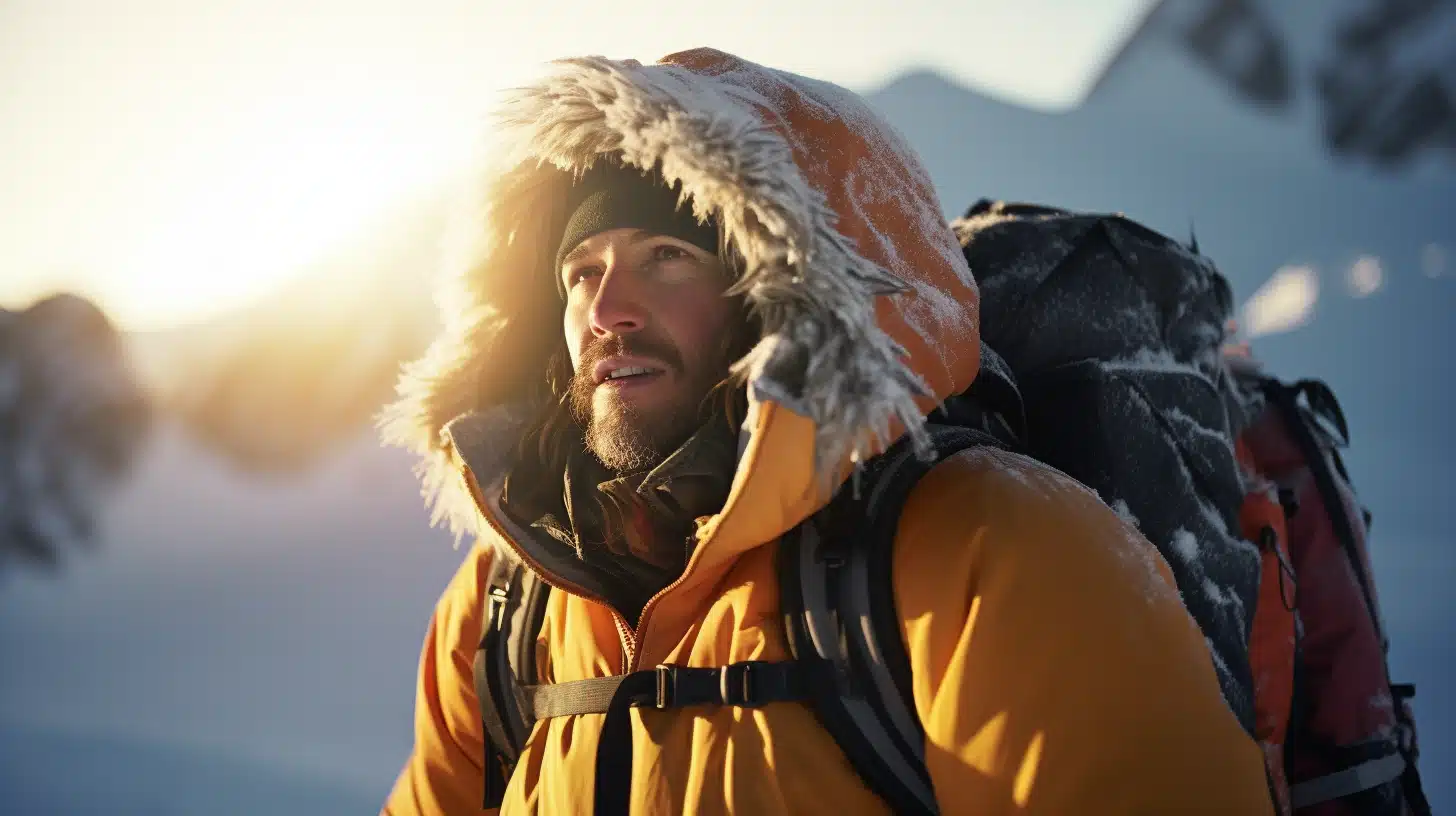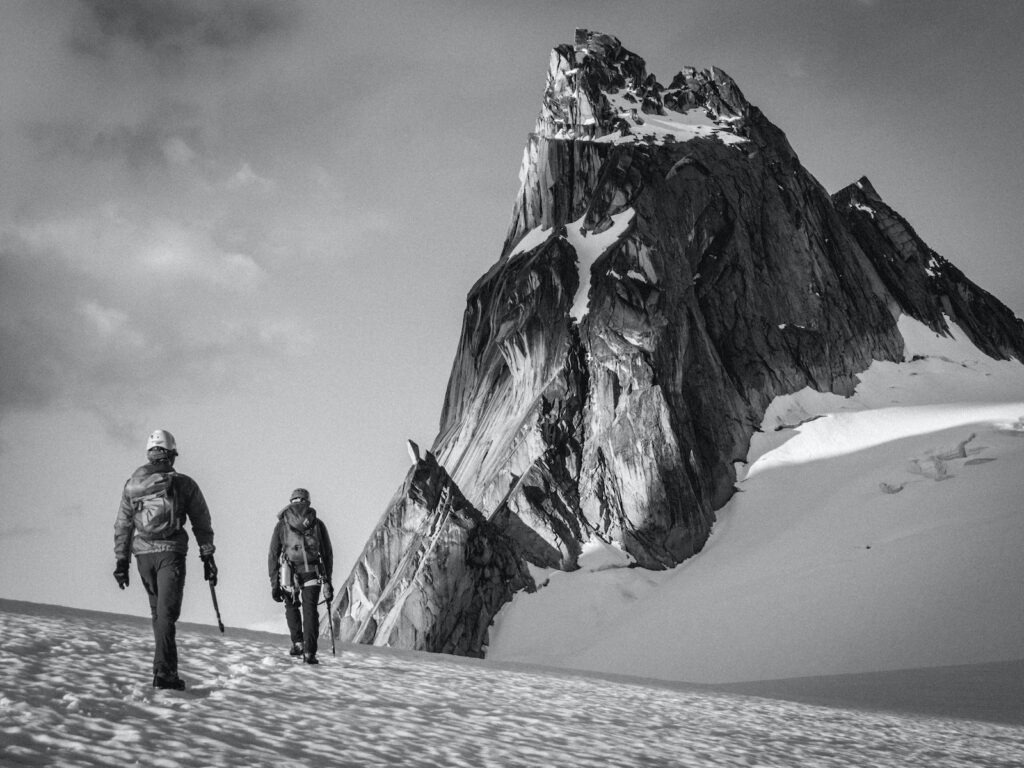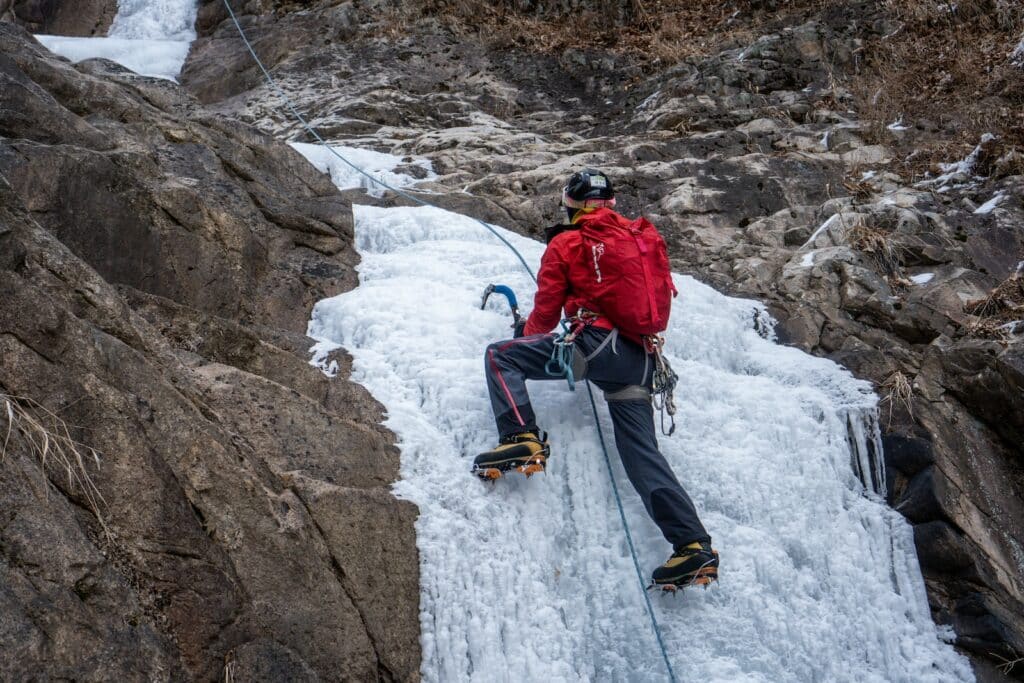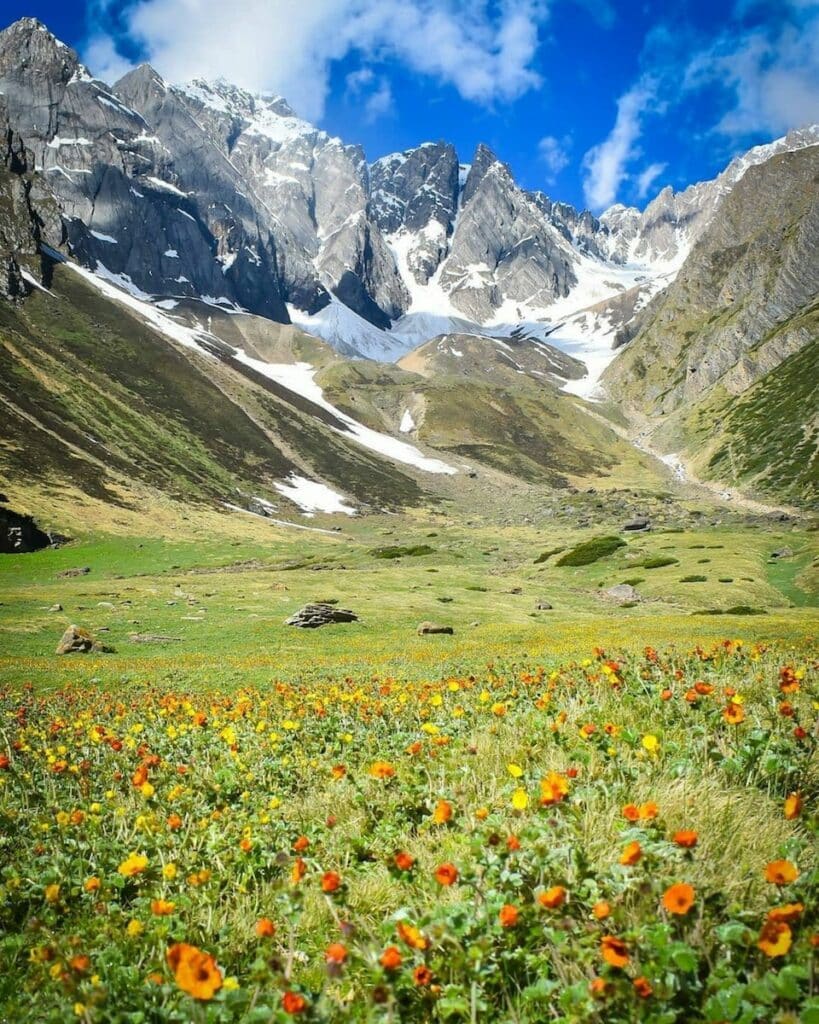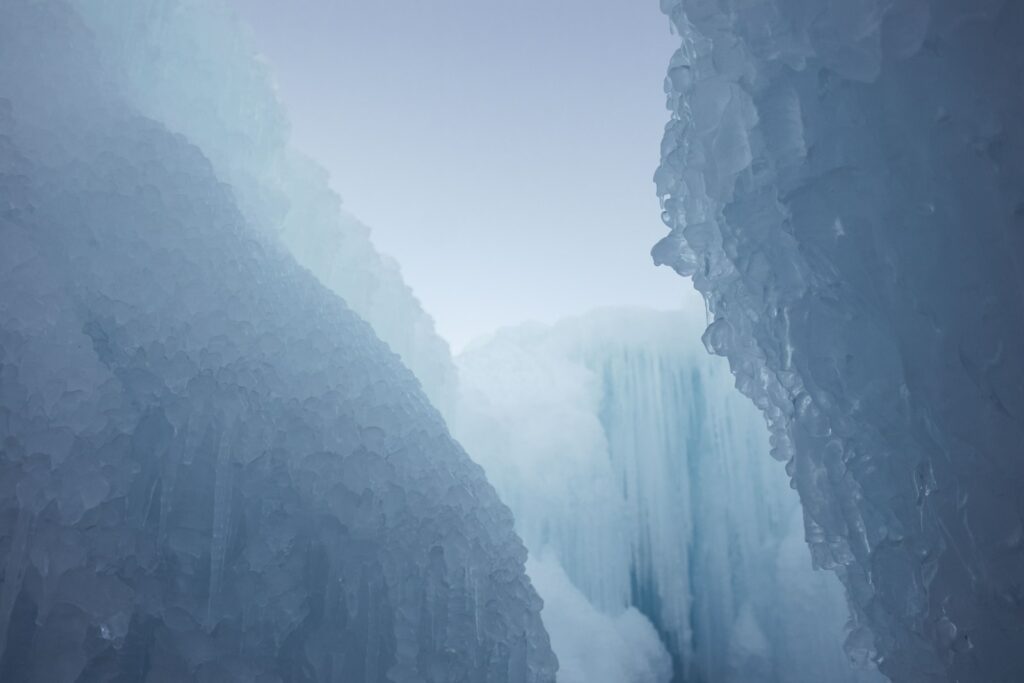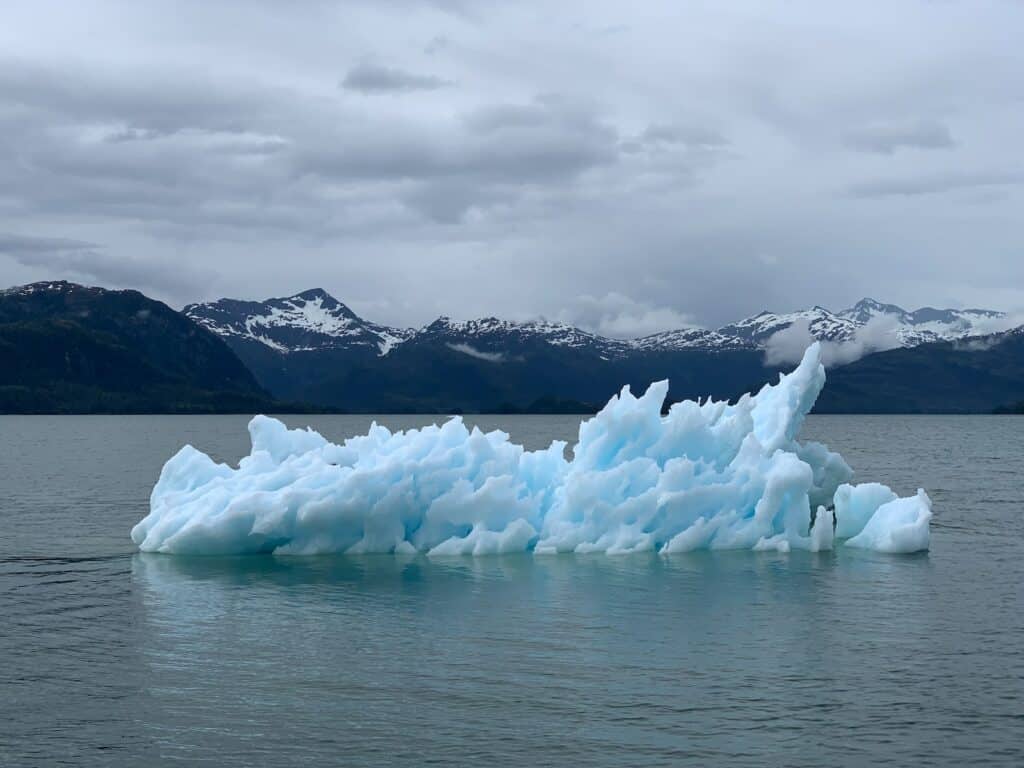Table of Contents
ToggleIce Climbing Basics
Ice climbing is an exhilarating sport that involves ascending frozen ice formations using specialized equipment and techniques. Whether you’re a beginner or an experienced rock climber looking to try something new, ice climbing offers a unique and challenging experience. In this section, we’ll provide an introduction to ice climbing and discuss the equipment needed to get started.
Introduction to Ice Climbing
Ice climbing combines elements of rock climbing and mountaineering with the added challenge of icy terrain. Climbing frozen waterfalls, ice pillars, and other ice formations requires physical strength, technical skills, and mental focus. It can be more physically demanding than rock climbing due to the additional effort required to swing ice tools and kick steps into the ice.
Ice climbers often use crampons, which are metal spikes that attach to their boots, to gain traction on the ice. These allow climbers to securely grip the ice and make upward progress. Additionally, ice climbers may use different types of ice screws to create anchors and protect themselves from falls. These screws are drilled into the ice and provide a secure point of attachment for ropes and other equipment.
Equipment Needed for Ice Climbing
To engage in ice climbing, it is essential to have the right equipment. Here is a list of some of the key pieces of gear needed for ice climbing:
- Ice Climbing Axes: Ice climbing axes, also known as ice tools, are specialized tools designed for gripping and pulling oneself up on the ice. They feature a curved pick at one end for penetrating the ice and a shaft with a spike at the other end for stability and balance. Ice climbing axes come in various sizes and designs, allowing climbers to choose the ones that suit their preferences and climbing style. Find more information on ice climbing axes.
- Ice Climbing Boots: Ice climbing boots are designed to provide warmth, insulation, and stability on icy terrain. These boots are typically rigid to provide support and prevent ankle injuries. They often have insulation to keep feet warm in cold conditions. It’s important to choose boots that fit well and provide a good balance between warmth and flexibility. Explore more about ice climbing boots.
- Crampons: Crampons are metal spikes that attach to the boots and provide traction on the ice. They have multiple points that dig into the ice, allowing climbers to navigate steep and slippery terrain. Crampons come in different designs, such as horizontal and vertical front points, to suit various ice climbing conditions. Discover more about ice climbing crampons.
- Harness: A climbing harness is an essential piece of equipment that connects the climber to the rope. It ensures safety and provides a point of attachment for other gear, such as ice screws and carabiners. A well-fitting harness that distributes the weight evenly is crucial for comfort and stability during climbs.
- Helmet: A helmet is essential for protecting your head from falling ice, rocks, or any other potential hazards. It should have a snug fit and meet safety standards to ensure maximum protection. Learn more about ice climbing helmets.
- Ropes and Anchors: Climbing ropes and anchors are used to secure climbers to the ice and provide protection in case of a fall. Dynamic ropes are commonly used in ice climbing due to their ability to absorb the impact of a fall. Anchors, such as ice screws, are drilled into the ice to create secure attachment points for the ropes.
These are just a few of the essential pieces of equipment needed for ice climbing. As you progress in your ice climbing journey, you may explore additional gear and accessories to enhance your experience and safety. For more information on ice climbing gear, equipment, and techniques, visit our article on ice climbing gear.
Remember, safety should always be a top priority when ice climbing. It is essential to receive proper training, gain experience, and climb with a knowledgeable partner or guide. Ice climbing can be a thrilling adventure, but it requires careful preparation and respect for the environment. Stay tuned for the next sections where we will delve into ice climbing techniques, safety precautions, and the factors that affect ice climbing conditions.
Ice Climbing Techniques
When it comes to ice climbing, having the right techniques is essential for a successful and safe ascent. Whether you’re a beginner or an advanced climber, understanding and mastering the proper techniques will greatly enhance your ice climbing experience. Let’s explore ice climbing techniques for both beginners and advanced climbers.
Ice Climbing Techniques for Beginners
For beginners, it’s important to start with the basics and gradually build your skills and confidence on the ice. Here are some key techniques to focus on:
- Swinging Ice Tools: Ice tools are the primary tools used in ice climbing. Practice swinging them into the ice to create stable placements. Focus on proper grip and wrist movement to generate efficient and controlled swings.
- Kicking Steps: Use your crampons, metal spikes that attach to your boots, to kick steps into the ice. This allows you to gain traction and create stable foot placements. Ensure that you kick with the front points of your crampons to maximize grip.
- Body Positioning: Maintain a balanced and stable body position on the ice. Lean slightly into the ice, keeping your weight centered over your feet. This helps maintain stability and conserves energy.
- Efficient Movement: Ice climbing can be physically demanding, so it’s important to be efficient with your movements. Minimize unnecessary exertion by using precise and controlled motions. Conserve energy by resting when possible and taking advantage of good footholds and handholds.
- Safety and Protection: Learn how to use ice screws and other ice protection to create secure anchors and protect yourself from falls. These tools are crucial for safe climbing and should be practiced under the guidance of experienced climbers.
Advanced Ice Climbing Techniques
Once you’ve mastered the basic techniques, you can progress to more advanced maneuvers and skills. These techniques are essential for tackling challenging ice formations and more technical climbs. Here are a few examples:
- Dry-Tooling: This technique involves using ice tools on rock surfaces. It requires precise placements and coordination between your tools and crampons. Dry-tooling allows you to climb sections of rock where there is limited or no ice.
- Mixed Climbing: Mixed climbing combines ice and rock climbing techniques. It requires a combination of ice tool placements, crampon placements, and traditional rock climbing techniques. This skill allows you to navigate mixed terrain where the ice may be intermittent.
- Lead Climbing: As an advanced climber, you may take on the role of the lead climber. This involves ascending first and placing protection while climbing. Lead climbing requires sound judgment, route-finding skills, and the ability to assess ice conditions.
- Specialized Equipment: Advanced ice climbing often involves using specialized equipment. This may include ice screws, ice hooks, and specialized ice tools with interchangeable picks. Familiarize yourself with these tools and practice using them effectively.
- Advanced Movement Techniques: Advanced climbers employ techniques such as front-pointing (using the front spikes of crampons for traction), figure-four and figure-nine moves (creating stable positions on the ice with arms and legs), and hooking (gripping and pulling on features in the ice with ice tools).
Remember, when advancing to more advanced techniques, it’s crucial to have proper training and guidance from experienced climbers or certified instructors. They can provide valuable insights, feedback, and help you improve your skills safely.
By mastering ice climbing techniques, you’ll be better equipped to tackle various ice formations and enjoy the exhilaration of ice climbing. Remember to always prioritize safety, use appropriate gear (ice climbing gear), and continuously practice and refine your techniques. Happy climbing!
Ice Climbing Safety
When it comes to ice climbing, safety should always be a top priority. The nature of this exhilarating sport requires climbers to take certain precautions to ensure a safe and enjoyable experience. In this section, we will explore some essential safety measures for ice climbing and discuss the importance of avalanche safety for ice climbers.
Safety Precautions for Ice Climbing
To ensure a safe ice climbing outing, it is crucial to follow these safety precautions:
- Wear a helmet: Protecting your head is essential in any climbing activity. Wearing a helmet can help prevent head injuries in the event of falling ice or rock.
- Use proper climbing techniques: Ice climbing can be physically demanding, so it’s important to use proper climbing techniques to minimize the risk of injury. Learn and practice techniques such as ice tool placement, footwork, and efficient movement on ice.
- Check local ice climbing conditions: Before embarking on an ice climb, it is advisable to check local ice climbing conditions and route conditions. Ice formations can change due to weather conditions and other factors, so being aware of the current conditions is crucial for safety.
- Assess the stability of ice: Ice stability is vital in ice climbing. Be prepared to assess the stability of the ice before proceeding with a climb. Look for signs of cracks, fractures, or unstable sections. If in doubt, consult with experienced climbers or local guides.
- Climb with a partner: Ice climbing should never be done alone. Always climb with a partner who is knowledgeable and experienced in ice climbing. Having a partner provides an extra layer of safety and support in case of an emergency.
- Communication and emergency plan: Establish clear communication with your climbing partner and agree upon a plan for emergencies. Ensure that you have a reliable method of communication and a strategy for self-rescue or assisting others, if necessary.
- Be prepared for changing conditions: Weather conditions can change rapidly in mountainous areas. Be prepared for changing conditions and have the necessary gear to stay warm, dry, and protected from the elements.
Avalanche Safety for Ice Climbers
Avalanche safety is crucial for ice climbers, especially when climbing in mountainous areas with snow and ice. Here are some key considerations for avalanche safety:
- Educate yourself: Gain knowledge about avalanche safety, including recognizing potential avalanche terrain, understanding snowpack stability, and learning rescue techniques. Take an avalanche safety course to acquire the necessary skills and knowledge.
- Check avalanche forecasts: Before heading out for an ice climbing adventure, check local avalanche forecasts and be aware of the current avalanche conditions in the area. This information will help you make informed decisions about where and when to climb.
- Carry essential avalanche safety gear: Always carry essential avalanche safety gear, including an avalanche transceiver, shovel, and probe. These tools are vital for locating and rescuing a person buried in an avalanche.
- Travel in avalanche terrain with caution: Be mindful of the terrain you are climbing in and avoid areas prone to avalanches. Stay away from steep slopes, convex slopes, and areas with recent avalanche activity.
- Practice safe route selection: Choose ice climbing routes that minimize exposure to avalanche terrain. Consult guidebooks, experienced climbers, or local guides for information on safe routes.
- Travel one at a time: When climbing in a group, travel one person at a time on steep or exposed sections. This reduces the risk of triggering an avalanche and ensures that others are not in harm’s way if an avalanche occurs.
Remember, avalanche safety is an ongoing process, and conditions can change rapidly. It is essential to stay updated on avalanche safety practices and be prepared to adapt your plans accordingly. By prioritizing safety and being well-prepared, you can enjoy the thrilling adventure of ice climbing while minimizing the inherent risks.
For more information on ice climbing safety, be sure to check out our article on ice climbing safety. Stay informed, stay safe, and enjoy the icy heights!
Ice Climbing Destinations
For ice climbing enthusiasts, exploring different ice climbing destinations can provide thrilling experiences and opportunities to conquer new challenges. Whether you’re a beginner or an experienced climber, there are numerous ice climbing spots around the world that offer breathtaking frozen landscapes and exciting routes. In this section, we will highlight popular ice climbing spots in Alberta, Canada, and some of the best ice climbing destinations globally.
Popular Ice Climbing Spots in Alberta, Canada
Alberta, Canada is renowned for its world-class ice climbing conditions, attracting climbers from all over the world. The Canadian Rockies, in particular, offer a wide variety of ice climbing experiences, ranging from beginner-friendly routes to more technical and challenging climbs. The winter season, from December to March, is the best time to explore ice climbing in Alberta, when the temperatures create ideal conditions for frozen waterfalls and ice formations.
Kananaskis Country, located in the heart of the Canadian Rockies, is a popular destination for ice climbers. It offers a wide range of classic ice climbing routes with varying difficulty levels, making it suitable for climbers of all skill levels. The area boasts stunning scenery, with frozen waterfalls and breathtaking landscapes that add to the allure of ice climbing in Alberta.
Best Ice Climbing Destinations Around the World
Beyond Alberta, there are several other incredible ice climbing destinations around the world that are worth exploring. Here are a few notable locations:
- Ouray Ice Park, Colorado, USA: The Ouray Ice Park is a renowned ice climbing destination, featuring over 200 ice and mixed routes in a unique man-made ice climbing park. It offers a variety of climbing experiences for all skill levels, making it a popular choice among ice climbers.
- Rjukan Valley, Norway: The Rjukan Valley in Norway is famous for its reliable ice climbing conditions. With over 150 routes across different grades, climbers can enjoy a range of challenges while surrounded by stunning frozen waterfalls and picturesque landscapes.
- Kandersteg, Switzerland: Kandersteg in Switzerland is a beloved ice climbing destination, offering a wide array of ice routes and frozen waterfalls. The area is also known for its strong ice climbing community and infrastructure, catering to climbers of all levels.
When planning an ice climbing trip, it’s important to remember that the ice climbing season varies depending on the destination and local conditions. It typically runs from November to April, but it’s crucial to check specific locations for the most accurate information and to ensure safety. Additionally, it’s essential to be aware of the potential impacts of climate change on ice climbing conditions, as some regions may experience changes in ice formation and stability over time.
Exploring different ice climbing destinations allows climbers to immerse themselves in the beauty of frozen landscapes while challenging their skills. Whether you choose to explore the icy terrains of Alberta, Canada, or venture further to international destinations, each ice climbing spot offers its own unique experiences and opportunities for adventure.
Assessing Ice Climbing Conditions
Before embarking on an ice climbing adventure, it is crucial to assess the conditions to ensure a safe and enjoyable experience. Several factors affect ice climbing conditions, including ice formation and weather conditions. By understanding these factors, you can make informed decisions and take appropriate precautions during your climb.
Factors Affecting Ice Climbing Conditions
- Temperature: Temperature plays a significant role in ice climbing conditions. Freezing temperatures are necessary for the formation and maintenance of ice. However, temperature fluctuations can impact the stability of the ice. Warmer temperatures can cause melting, leading to unstable and potentially dangerous conditions. On the other hand, extremely cold temperatures can make the ice brittle and more challenging to climb. Monitoring the temperature trends before and during your climb is essential for assessing the ice conditions.
- Precipitation: The type and amount of precipitation can greatly influence ice climbing conditions. Snowfall can insulate the ice, potentially making it weaker and less stable. Conversely, freezing rain or sleet can create a layer of ice on top of existing ice, increasing its strength and stability. It is important to consider recent weather events and the type of precipitation that has occurred to evaluate ice conditions accurately.
- Humidity: Humidity levels affect ice formation and the quality of the ice. Higher humidity can lead to more moisture in the air, which may result in the formation of softer and less stable ice. Lower humidity levels can produce harder and more compact ice. Understanding the humidity levels in the area can help you assess the quality and reliability of the ice for climbing.
- Wind: Wind can have a significant impact on ice climbing conditions. Strong winds can affect ice formation by altering the rate at which droplets freeze. Wind can also cause ice to become thin or uneven, creating potential hazards. It is important to consider wind speed and direction when assessing the ice conditions, as they can provide valuable insights into the stability and safety of the climbing routes.
Understanding Ice Formation and Weather Conditions
Ice formation is a complex process influenced by various factors, including temperature, humidity, and precipitation. Understanding how ice forms can provide valuable insights into its strength and stability for climbing.
Icing is the deposit or coating of ice on an object caused by the freezing of liquid hydrometeors, usually supercooled droplets. The rate of catch of droplets is affected by the size of the droplets, airspeed, and the curvature of the leading edge of the wing. Thin wings catch more droplets than thick wings. Icing affects not only wings and control surfaces but also other components of aircraft. The three main types of ice accretion are clear ice, rime ice, and mixed ice. Clear ice forms from large supercooled water droplets and can disrupt airflow and increase drag. Rime ice is an opaque, milky-white deposit that forms from small supercooled droplets. Mixed ice has characteristics of both clear and rime icing.
When assessing ice climbing conditions, it’s essential to gather up-to-date weather information from reliable sources such as local meteorological services or climbing organizations. Pay attention to forecasts and observations related to temperature, precipitation, and wind conditions. Additionally, consider the type of ice you will encounter, such as alpine ice or waterfall ice, as they may have different characteristics and require varying climbing techniques.
By carefully evaluating the factors affecting ice climbing conditions and understanding the formation of ice, you can make informed decisions about when and where to climb. Remember to prioritize safety and always consult experienced climbers or guides for guidance in assessing the conditions.
Climate Change and Ice Climbing
Ice climbing conditions are not immune to the effects of climate change. The increasing temperatures around the world have had a significant impact on the availability and quality of ice climbing conditions in various regions. It is important for ice climbers to understand the impact of climate change and adapt to the changing conditions.
Impact of Climate Change on Ice Climbing Conditions
The rising temperatures due to climate change have led to a decrease in the availability and quality of ice climbing conditions in many popular destinations. Alpine regions, such as the European Alps, have experienced a considerable reduction in the number of days suitable for ice climbing over the years. In fact, between 1970 and 2019, the alpine regions of the European Alps saw a 23% decrease in such days. Similarly, the Canadian Rockies have witnessed a progressive shortening of the ice climbing season by about 20 days per decade due to warmer temperatures.
The impact of climate change on ice climbing conditions is not limited to traditional ice climbing destinations. Even previously reliable spots, like the Sierra Nevada in the United States, are experiencing a decline in ice climbing conditions. This decline not only affects the recreational aspect of ice climbing but also has negative implications for the local economies that heavily rely on ice climbing tourism.
Regions like the Khumbu region in Nepal have also witnessed a deterioration in ice climbing conditions. Increased temperatures and reduced snowfall have led to faster melting and less stable ice formations. Over the past decade, the average temperatures in the Khumbu region have risen by 1.5 degrees Celsius, resulting in thinner ice layers and less reliable climbing conditions. These changes are consistent with global warming trends observed in other mountainous regions worldwide.
Strategies for Adapting to Changing Ice Climbing Conditions
As ice climbers, it is crucial to adapt to the changing conditions caused by climate change. Here are some strategies to consider:
- Stay Informed: Keep yourself updated on the latest information about ice climbing conditions in different regions. Consult local climbing guides, ice climbing associations, and online resources for current conditions and safety considerations.
- Flexibility and Travel: Be willing to travel to areas with more favorable ice climbing conditions. Due to the impact of climate change, certain regions may no longer provide reliable conditions. Exploring new destinations can broaden your ice climbing opportunities.
- Timing: Plan your ice climbing trips carefully. Optimal conditions may be limited to certain times of the year or specific periods when temperatures are lower. Consider consulting experts or local climbers for advice on the best times to visit specific areas.
- Diversify Climbing Skills: Expand your climbing skills beyond ice climbing. Developing proficiency in mixed climbing, dry tooling, or other related disciplines can provide alternative options when ice climbing conditions are not ideal.
- Environmental Stewardship: Practice responsible climbing and leave-no-trace principles to minimize your impact on fragile ice formations. By respecting the environment, we can help preserve ice climbing resources for future generations.
Adapting to changing ice climbing conditions requires a combination of flexibility, knowledge, and a willingness to embrace new challenges. By staying informed, diversifying your skills, and being mindful of the environment, you can continue to enjoy the exhilaration of ice climbing while respecting the delicate balance of nature.

